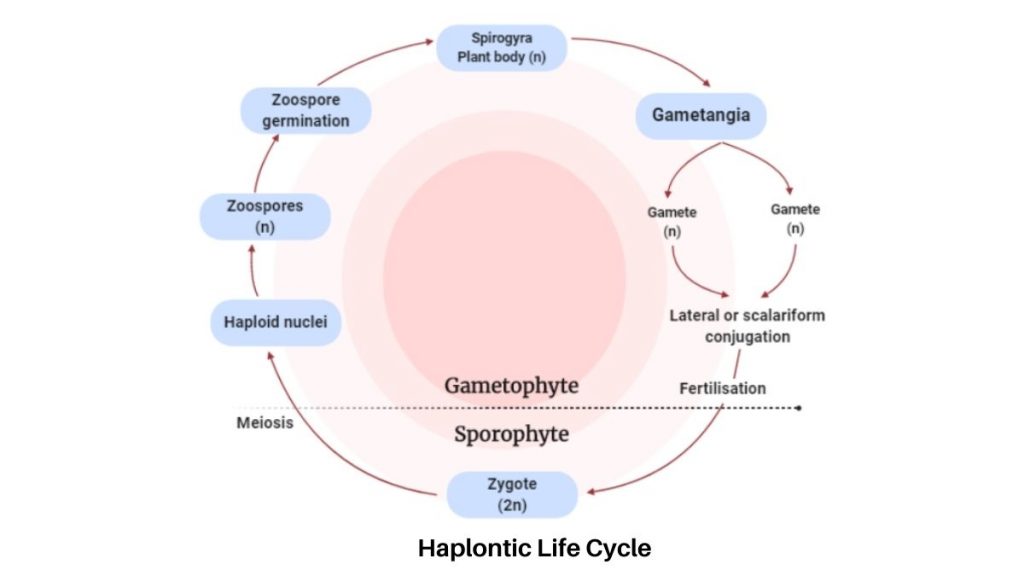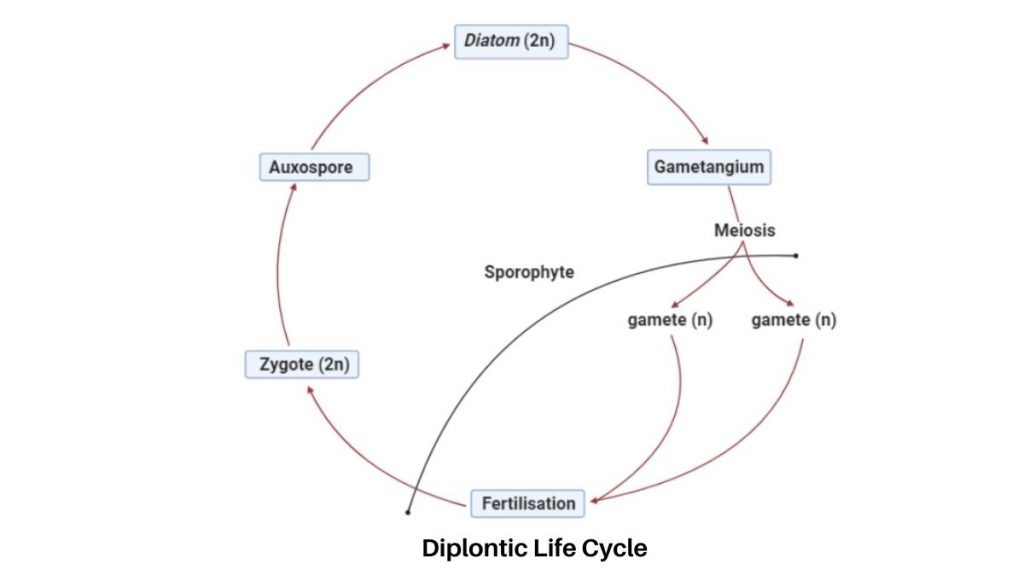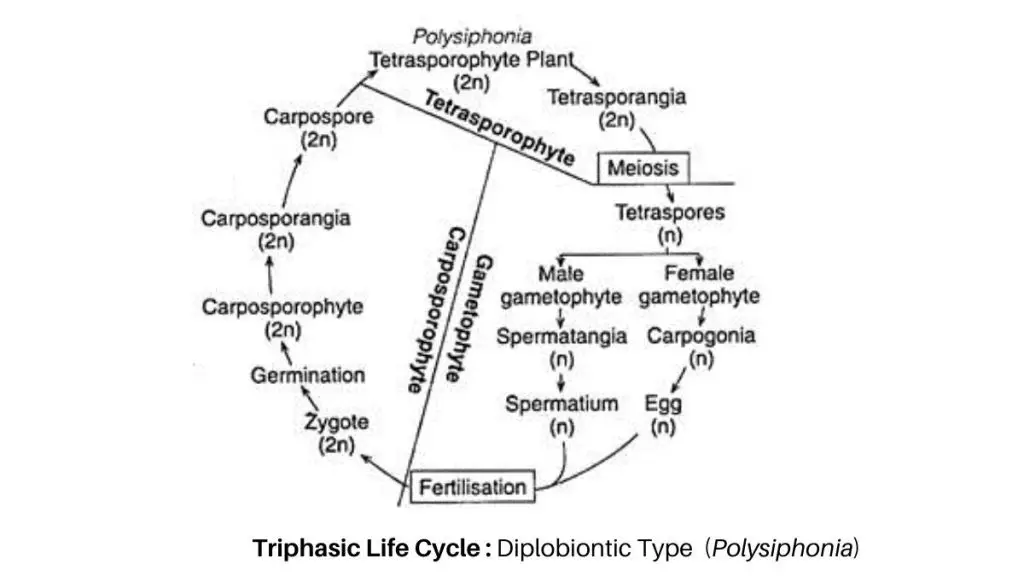Life cycle of Algae
Sequential changes of the different pages through which an organism completes the life process, starting from zygote to the zygote of the next generation is called the life cycle.
There are four types of life cycle in algae such as;
1. Haplontic Life Cycle
- In this life cycle plants are haploid.
- The Haplontic Life Cycle is a diphasic cycle and considered as the simplest and most primitive type of lifecycle.
- There is two-stage in haplontic life cycle such as gametophyte (haploid) and sporophyte (diploid) which is represented only by zygote.
- The Haploid gametes are developed within the gametangium of the gametophytic plant. Then two haploid gametes are fused and formed a zygote and enter to the diploid stage or sporophytic phase of the life cycle.
- During the germination, the zygotes are meiotically divided into haploid (n) zoospores, which are then developed into haploid plants. This is known as the gametophyte (haploid) stage.
- The haplontic life cycle is also known as the monogenic life cycle.
- Example: Mostly found in Chlamydomonas, Ulothrix, Oedogonium, Spirogyra.

2. Diplontic Life Cycle
- In this life cycle plants are diploid.
- At first, the sporophytic plant body develops sex organs.
- Then sex organs undergo meiosis processes and develop gametes. These gametes represent the gametophytic stage.
- After that, the gametes are fertilized and form a zygote.
- This zygote forms a sporophytic plant body.
- Example: Bacillariophyceae, Sargassum, Fucus Phaeophyceae.

3. Diplohaplontic Life Cycle
- The diplohaplontic life cycle has equally prominent haploid and diploid phases which are represented by two distinct vegetative individuals.
- Their chromosome number and function are different.
- The reproduction of the haploid gametophytic plant is followed by the sexual method whereas the diploid sporophytic plant by the asexual process.
- In this life cycle, the sporogenic meiosis and fusion of gametes is responsible for the alternation of two vegetative individuals.
The Diplohaplontic Life Cycle is two type such as;
(a) Isomorphic or Homologous Diplohaplontic Type
- In Homologous Diplohaplontic Type, the sporophytic and gametophytic plants are morphologically similar and free living.
- In this type, the gametophytic plant (haploid) forms gametes, which then undergo sexual reproduction and form zygote.
- After that, the zygote undergoes germination processes and form a sporophytic (diploid) plant.
- This sporophytic plant undergoes meiosis processes and form haploid zoospores.
- After that these zoospores are responsible for the development of new gametophytic plant.
- Example: Clapdohora, Ulva, Draparnaldiopsis of Chlorophyceae, and Ectocarpus of Phaeophyceae follow this life cycle.
(b) Heteromorphic or Heterologous Diplohaplontic Type
- In Heterologous Diplohaplontic Type the sporophytic (diploid) and gametophytic (haploid) plants are morphologically different.
- As compared to gametophyte the sporophyte is complex and much elaborate whereas the gametophyte is simple and small as found in Laminaria of Phaeophyceae.
- In Cutlaria the gametophyte is dominant over sporophyte.
- The gametophytic plant body in Laminariais is composed of minute filaments that form gametes.
- The gametes are fused and produce zygote, after that it germinates directly within a sporophytic plant which is several meters in length and microscopic in nature.
- After meiotic division, the sporophytic plant develops zoospores which are then germinate and produce a haploid gametophytic plant.
4. Triphasic Life Cycle
In this type, there is a succession of three distinct generations. The triphasic life cycle is two types such as;
- Haplobiontic Type
- The gametophytic (haploid) phase in Haplobiontic Type is elaborate, dominant and persists for a long time as compared to the sporophytic (diploid) phase which is represented only by zygote
- Haplobiontic type and two successive haploid generations are interrupted only by the diploid zygote stage indicate its triphasic nature.
- It can be observed in primitive members of Rhodophyceae like Batrachospermum and Nemalion.
- The gametophytic plant body in Batrachospermum develop sex organs which are then forms male (spermatium) and female (egg) gametes. These gametes are fused and form a zygote.
- After that, the zygotes undergo meiosis and form a haploid gametophytic plant, the carposporophyte.
- Then the carposporophyte form carposporangium which is then develop a haploid carpospores.
- After that a new free-living gametophytic plant is developed by the germination of carpospores.
- It has three phases such as Haploid carposporophyte, Haploid gametophyte, and Diploid zygote.
- Diplobiontic Type
- Diplobiontic Type consists of one gametophytic phase and two sporophytic phases which indicate its triphasic nature.
- In this type, the sporophytic phase is more elaborate and persists for long duration as compared to the gametophyte i.e., diplobiontic type.
- This life cycle is observed in Polysiphonia, a member of Rhodophyceae.
- The gametophytic phase in Polysiphonia is represented by two different types of gametophytic plants such as male and female plants, which bear spermatangium and carpogonium respectively.
- Later, the sperms and eggs develop from spermatangium and carpogonium respectively.
- The male and female gamete (sperm and egg) fuse and produce zygote.
- The zygote (2n) develops into a diploid carpospophytic phase, and diploid carpospores are formed within the carposporophyte.
- After that, the carpospores are germinated and form diploid tetrasporophytic plants.
- Next, a diploid tetrasporangia is developed from the tetrasporo- phytic plant and each diploid tetrasporangia produces four tetraspores (n) by meiotic division.
- Among these four tetraspores two develop male gametophyte and the other two develop female gametophyte.
- There are three-phase in Diplobiontic Type such as Haploid gametophyte, Diploid carposporophyte, and Diploid tetrasporophyte.

ये बहुत ही अच्छी साइट है
Thank You Dear
Can you cite the books that you read for the respective posts information especially about algae cells. That would be so helpful.
I’m not that much of a online reader to be honest but your sites really nice, keep it up! I'll go ahead and bookmark your site to come back down the road. Cheers
Thank you
Chekc